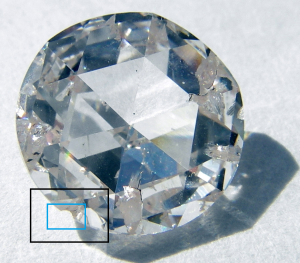To understand the magnificence of the world’s most sought-after gem, the diamond, one must dive deep into its anatomy. Many of its intriguing facets lay beneath the surface, invisible to the naked eye. Among these are inclusions, internal or surface characteristics that can enhance or reduce the stone’s value. Bearded girdle, a type of diamond inclusion, is one such feature, which is captivating in its way.
The girdle of a diamond refers to its outermost edge. It’s the belt or band that forms the perimeter, separating the crown (top) from the pavilion (bottom). A bearded girdle, in simple terms, is a girdle with minute fractures or “beards” that look similar to tiny hairs under magnification.
The Formation of a Bearded Girdle
Gemstones are nature’s work of art, and diamonds are no exception. They form deep within the Earth’s crust over billions of years, under intense heat and pressure. When these conditions cause carbon atoms to bond, diamonds are formed.
A bearded girdle occurs when a diamond’s girdle isn’t polished correctly. If the diamond is cut too hastily or if the cutting tool is too aggressive, it can lead to minute fractures around the girdle, resulting in what gemologists call a “bearded” or “fuzzy” girdle.
How a Bearded Girdle Affects a Diamond’s Value
Like most inclusions, a bearded girdle can influence a diamond’s value. This effect, however, largely depends on the severity of the bearding. If the bearded girdle is minimal and doesn’t extend into the diamond, it may not significantly affect the value.
However, if the bearding is extensive, reaching into the diamond’s crown or pavilion, it can impact the overall appearance and, consequently, the gemstone’s value. Extensive bearding can make a diamond look cloudy or hazy, thereby reducing its appeal.
Identifying a Bearded Girdle
To the untrained eye, a bearded girdle can be challenging to identify. A 10x jeweler’s loupe or a gemological microscope is usually required to see the minute fractures. Skilled gemologists and diamond graders can identify a bearded girdle under such magnification. They look for the characteristic “fuzziness” or tiny hair-like fractures along the diamond’s edge.
Gemological laboratories like the GIA (Gemological Institute of America) describe the girdle condition in their reports, which can serve as a reliable guide for buyers.
Bearded Girdle and the 4Cs
The 4Cs—Carat, Cut, Clarity, and Color—are the universal method for assessing diamond quality. A bearded girdle, given its role as an inclusion, can influence the Clarity and Cut grading.
As an aspect of diamond cutting, a bearded girdle can potentially affect the cut grade, especially if the bearding is a result of poor cutting practices. The Clarity grade, representing the absence of inclusions and blemishes, can also be impacted if the bearding is extensive.
The Role of Proper Polishing in Preventing Bearded Girdles
Proper polishing plays a crucial role in the final appearance and quality of a diamond. When a diamond is cut and polished with precision and care, the chances of a bearded girdle occurring are significantly reduced.
The girdle can either be faceted, bruted, or polished, each with its pros and cons. However, a well-polished girdle often ensures the right balance between aesthetics and durability, thereby preventing the occurrence of a bearded girdle.
Conclusion: Beauty Beyond Perfection
Diamonds, like other gemstones, are products of nature’s craftsmanship. They aren’t created perfectly, and their unique characteristics add to their allure. A bearded girdle is one such attribute that lends a diamond its distinctive charm.
While it’s true that extensive bearding can reduce a diamond’s value, it’s also a reminder of the gemstone’s journey—from the depths of the Earth to the jeweler’s workshop. Thus, the bearded girdle, much like any inclusion, tells a tale of creation, transformation, and beauty beyond perfection.
